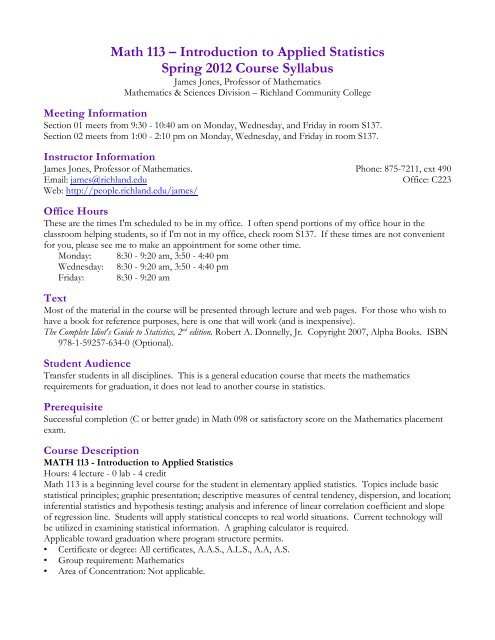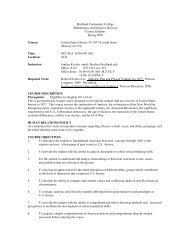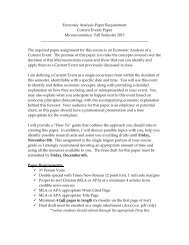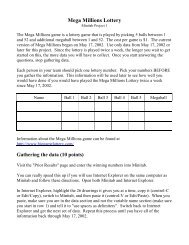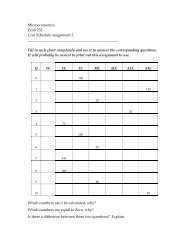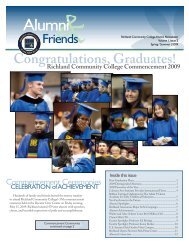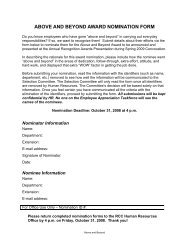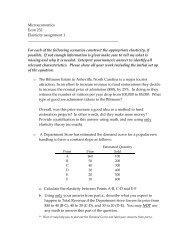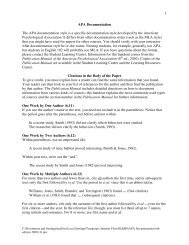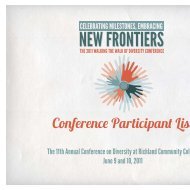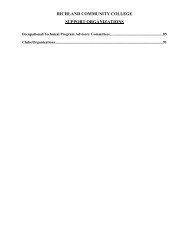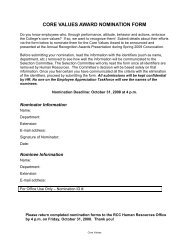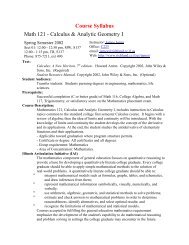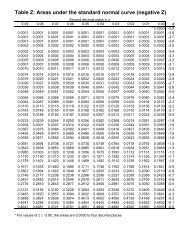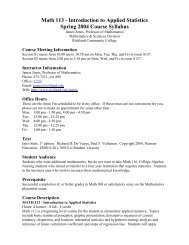Math 113 â Introduction to Applied Statistics Spring 2012 Course ...
Math 113 â Introduction to Applied Statistics Spring 2012 Course ...
Math 113 â Introduction to Applied Statistics Spring 2012 Course ...
You also want an ePaper? Increase the reach of your titles
YUMPU automatically turns print PDFs into web optimized ePapers that Google loves.
<strong>Math</strong> <strong>113</strong> – <strong>Introduction</strong> <strong>to</strong> <strong>Applied</strong> <strong>Statistics</strong><strong>Spring</strong> <strong>2012</strong> <strong>Course</strong> SyllabusJames Jones, Professor of <strong>Math</strong>ematics<strong>Math</strong>ematics & Sciences Division – Richland Community CollegeMeeting InformationSection 01 meets from 9:30 - 10:40 am on Monday, Wednesday, and Friday in room S137.Section 02 meets from 1:00 - 2:10 pm on Monday, Wednesday, and Friday in room S137.Instruc<strong>to</strong>r InformationJames Jones, Professor of <strong>Math</strong>ematics. Phone: 875-7211, ext 490Email: james@richland.eduOffice: C223Web: http://people.richland.edu/james/Office HoursThese are the times I'm scheduled <strong>to</strong> be in my office. I often spend portions of my office hour in theclassroom helping students, so if I'm not in my office, check room S137. If these times are not convenientfor you, please see me <strong>to</strong> make an appointment for some other time.Monday: 8:30 - 9:20 am, 3:50 - 4:40 pmWednesday: 8:30 - 9:20 am, 3:50 - 4:40 pmFriday: 8:30 - 9:20 amTextMost of the material in the course will be presented through lecture and web pages. For those who wish <strong>to</strong>have a book for reference purposes, here is one that will work (and is inexpensive).ndThe Complete Idiot's Guide <strong>to</strong> <strong>Statistics</strong>, 2 edition. Robert A. Donnelly, Jr. Copyright 2007, Alpha Books. ISBN978-1-59257-634-0 (Optional).Student AudienceTransfer students in all disciplines. This is a general education course that meets the mathematicsrequirements for graduation, it does not lead <strong>to</strong> another course in statistics.PrerequisiteSuccessful completion (C or better grade) in <strong>Math</strong> 098 or satisfac<strong>to</strong>ry score on the <strong>Math</strong>ematics placementexam.<strong>Course</strong> DescriptionMATH <strong>113</strong> - <strong>Introduction</strong> <strong>to</strong> <strong>Applied</strong> <strong>Statistics</strong>Hours: 4 lecture - 0 lab - 4 credit<strong>Math</strong> <strong>113</strong> is a beginning level course for the student in elementary applied statistics. Topics include basicstatistical principles; graphic presentation; descriptive measures of central tendency, dispersion, and location;inferential statistics and hypothesis testing; analysis and inference of linear correlation coefficient and slopeof regression line. Students will apply statistical concepts <strong>to</strong> real world situations. Current technology willbe utilized in examining statistical information. A graphing calcula<strong>to</strong>r is required.Applicable <strong>to</strong>ward graduation where program structure permits.• Certificate or degree: All certificates, A.A.S., A.L.S., A.A, A.S.• Group requirement: <strong>Math</strong>ematics• Area of Concentration: Not applicable.
Illinois Articulation Initiative (IAI)The Illinois Articulation Initiative is a statewide transfer agreement. Their website is athttp://www.itransfer.org.<strong>Math</strong> <strong>113</strong>, <strong>Introduction</strong> <strong>to</strong> <strong>Applied</strong> <strong>Statistics</strong>, satisfies the Illinois Articulation Initiative Definition of aGeneral Education <strong>Math</strong>ematics <strong>Course</strong>. It corresponds <strong>to</strong> M1902, General Education <strong>Statistics</strong>.General <strong>Course</strong> ObjectivesWhile learning statistics is certainly one of the goals of this course, it is not the only objective. Uponcompletion of this course, the student should be able <strong>to</strong> ...• demonstrate comprehension and understanding in the <strong>to</strong>pics of the course through symbolic, numeric,and graphic methods• demonstrate the use of proper mathematical notation• use technology when appropriate and know the limitations of technology• work with others <strong>to</strong>wards the completion of a common goal• use deductive reasoning and critical thinking <strong>to</strong> solve problemsSpecific <strong>Course</strong> ObjectivesIn all of the following objectives, the student should be able <strong>to</strong> think, show, and tell what is happening.Concentration will not be on the memorization of formulas but on the conceptual understanding of thestatistics. Technology will be heavily emphasized <strong>to</strong> obtain the results, but the emphasis is on the statistics,not the technology.Upon successful completion of this course, the student should be able <strong>to</strong> ...• describe a sample and know which statistics are appropriate for measuring center and spread• display categorical and quantitative data using pie charts, his<strong>to</strong>grams, crosstabulations, frequencydistributions, scatter plots, dot plots, and box plots as appropriate• understand randomness, sampling techniques, and experiments• determine simple and compound probabilities using probability rules and simulation techniques• find the mean and standard deviation of a probability distribution• understand and use the binomial distribution• work with the normal distributions and determine if populations are normally distributed• understand the properties of the standard normal distribution• understand the sampling distribution models for means and proportions• find confidence intervals for proportions and means of one and two samples• conduct hypothesis tests for proportions and means of one and two samples• apply the classical, p-value, and confidence interval approaches <strong>to</strong> hypothesis testing• find and test the significance of the linear correlation coefficient• find and use the appropriate regression equation• compare different models in multiple regression (time permitting).• perform chi-square goodness of fit tests and test for independence• conduct one-way and two-way (time permitting) analysis of variance problems• understand the workings of the analysis of variance table and its application <strong>to</strong> simple regression,multiple regression, one-way ANOVA, and two-way ANOVA situations.A detailed <strong>to</strong>pical outline of the content covered in this course is at the end of this syllabus.Type of InstructionInstruction in this course will primarily occur through project-based learning. Along with this, we will usediscussion, problem solving, activities, individual and group work, student questions, student participation,
and lecture. Students are expected <strong>to</strong> have read the material before class and are strongly encouraged <strong>to</strong>come <strong>to</strong> class with a list of questions and <strong>to</strong> ask these questions. A substantial portion of this class willinvolve collaborative work with other students.Method of EvaluationEvaluation could include any of the following: problem solving exams, objective exams, essays, researchpapers, oral presentations, group projects, individual projects, classroom participation, classroom activities,quizzes, and homework.This course will use a non-traditional approach <strong>to</strong> evaluation. There will be no exams. Instead, the coursewill be project-based with near-daily assessment of your progress. These regular assessments will, for themost part, be incorporated in<strong>to</strong> the class presentation. The instruc<strong>to</strong>r will ask questions; you will providefeedback, and that will be used <strong>to</strong> help determine your grade. You will provide your responses electronicallyso that you can get immediate feedback on whether or not you understand the material and the instruc<strong>to</strong>rcan get a sense of where the class is. The instruc<strong>to</strong>r can then use this information <strong>to</strong> make adjustments inthe schedule. Because these are incorporated in<strong>to</strong> the course, there is no way <strong>to</strong> make up these assessmentsif you miss class.Sometimes your responses will be used as a participation grade. When this happens, you are awarded pointsfor being in class and providing feedback. It doesn't matter whether or not you get the right answer andsometimes there won't even be a right answer. Participation will compose 10% of your overall grade in thecourse.Other times the feedback will be used <strong>to</strong> assess how well you have learned and can apply the concepts beingtaught. In these cases, you will be awarded points for providing the correct answers <strong>to</strong> the questions. Someinstruc<strong>to</strong>rs drop the lowest quiz (or two), but because these assessments will be worth different amounts ofpoints, that becomes difficult <strong>to</strong> do. Instead, there will be a 10% grace fac<strong>to</strong>r applied <strong>to</strong> these assessments.That means that if you take a 10 point quiz, it will get recorded in the grade book as being a 9 point quiz. Ifyou happen <strong>to</strong> score 10 points on it, then you have a little extra <strong>to</strong> help your grade. Conceptualunderstanding will compose 50% of your overall grade in the course.The other main component of the course will be projects. Some of these projects will be individual andsome of them will involve group work. Projects will compose 40% of your overall grade in the course.Grading PolicyLetter grades will be assigned <strong>to</strong> final adjusted scores as follows:A: 90-100% B: 80 - 89% C: 70-79% D: 60-69% F: below 60%The final score will be weighted according <strong>to</strong> these three categories:Concepts: 50% Projects: 40% Participation: 10%There is a web page available so that you can use <strong>to</strong> check your grades throughout the semester. If you areconcerned about your grades, see the instruc<strong>to</strong>r.There is no rounding of grades or extra credit in this course beyond the 10% grace fac<strong>to</strong>r on the conceptassessments. The course is a marathon, not a sprint at the end. You must perform consistently throughoutthe semester <strong>to</strong> earn a good grade. If you are one point short of the next higher grade at the end of thesemester, you will get the lower grade.Assignments are due at the beginning of the class period on the date they are due. The instruc<strong>to</strong>r may begracious and allow you <strong>to</strong> turn them in later that day without counting them late, but do not count on hisgraciousness. Late assignments lose 20% of their value per class period. The instruc<strong>to</strong>r reserves the right <strong>to</strong>apply this rule <strong>to</strong> missed exams as well as regular assignments. No late work will be accepted after the final.The student must notify the instruc<strong>to</strong>r that late work has been submitted.
Written WorkAll written work should be in a typed (word processor) format. There should be a cover page with the titleof the assignment and the student's name. All work should be double spaced. Papers are <strong>to</strong> be stapled<strong>to</strong>gether in the upper left hand corner. All reference works used, including books, videos, etc., are <strong>to</strong> becited using APA (preferred) or MLA notation. All work is <strong>to</strong> utilize the English language correctly. It issuggested that the Academic Success Center be utilized for assistance in the preparation of written work. Ifwritten work is submitted late, the instruc<strong>to</strong>r may take appropriate deductions from the grade.Attendance PolicyIf you miss the first day of class or any two consecutive days after that without communicating with theinstruc<strong>to</strong>r, you may be dropped.Attendance is recorded every class period. Since the course does not directly follow a textbook, attendanceis the primary method of obtaining the information in the course. <strong>Statistics</strong> is a cumulative subject and eachday builds on the previous day's material.Students who, because of excessive absences, cannot complete the course successfully, are required <strong>to</strong> beadministratively dropped from the class at midterm. If a student s<strong>to</strong>ps attending after midterm, it is thestudent's responsibility <strong>to</strong> withdraw <strong>to</strong> avoid an "F". Do not s<strong>to</strong>p attending and assume that you will bewithdrawn from the class by the instruc<strong>to</strong>r.The student is responsible for all assignments, changes in assignments, or other verbal or writteninformation given in the class, whether in attendance or not. There will be some kind of assessment almostnearly every day as part of the classroom presentation. These may not be made up if you miss class (youmay attend the other section of the course on the same day provided that there are available seats).If a student must miss class, a call <strong>to</strong> the instruc<strong>to</strong>r (RCC's phone system has an answering system) shouldbe made or an email message (preferred) sent.Calcula<strong>to</strong>rsA calcula<strong>to</strong>r is required for this course. It does not have <strong>to</strong> be a graphing calcula<strong>to</strong>r, but it should be ascientific calcula<strong>to</strong>r with the ability <strong>to</strong> square a number and find the square root of a value. You areresponsible for knowing how <strong>to</strong> use your calcula<strong>to</strong>r. If you do not know, then ask. Bring the calcula<strong>to</strong>revery day <strong>to</strong> class.Additional SuppliesThe student should bring a pencil, paper, and calcula<strong>to</strong>r <strong>to</strong> class each day. You may occasionally want aruler or graph paper. There will be a paper punch and stapler in the classroom.Collaborative WorkThis is an applied statistics course. We will be doing several activities and projects in this course that requiregroup work. Much of this time will be spent in the classroom, but there will also be time outside of classrequired. Computer software will be used for analysis of the data.Some of these projects will be designed by the instruc<strong>to</strong>r and involve the entire class. One of the projectswill be a caps<strong>to</strong>ne project designed by each individual group and approved by the instruc<strong>to</strong>r. This projectwill include a written paper and oral presentation of the results <strong>to</strong> the class of their findings.TechnologyIn this course, we will concentrate on understanding the statistics and relegate the roll of finding thestatistics <strong>to</strong> technology. We are going <strong>to</strong> embrace the technology, but the course is not about thetechnology, it's about the statistics. You may feel overwhelmed, especially if you're not comfortable around
computers, but we will try <strong>to</strong> make it as friendly as possible without stifling those power users who want <strong>to</strong>really enhance their material.Most of the technology we're going <strong>to</strong> use is free, open source, or web-based so that there is no additionalcost <strong>to</strong> the students and you can use them after you leave this course. Some software is commercial, but inthose cases, Richland Community College has a license <strong>to</strong> use them. Here is a list of some of the computerpackages we may use in this course.MinitabMinitab is the statistical software package of choice for this class. It is powerful and makes nice graphs.Minitab is fairly easy <strong>to</strong> use if you are familiar with a spreadsheet like Excel.Minitab is installed on the computers in S137, the Academic Success Center, and the Open Computer Lab.Richland's license for Minitab does not allow for home use, but students will be able <strong>to</strong> get most of theirwork done at school. There is a 30 day trial version of Minitab available on the web for downloading athttp://www.onthehub.com/minitab. You may also purchase a six month copy that will last the entiresemester. Minitab is available only for Windows.The number one suggestion from former students is <strong>to</strong> rent Minitab so that you don't have <strong>to</strong> stay at school<strong>to</strong> do your work.Me d iaWikiMuch of the collaboration within this class will be done inside of a Wiki. Most students have used a Wiki(Wikipedia.org), but we will be creating the content rather than just looking it up. MediaWiki is the wikisoftware that Wikipedia uses.MediaWiki is a web-based application, so students may use it from anywhere they have Internet access.More information about MediaWiki is available at http://www.mediawiki.orgQue s tio n Pre s sQuestion Press is a web-based classroom and audience response system. It allows for interactive quizzing,feedback, and participation. It works from desk<strong>to</strong>p computers and mobile devices and will be the maininstrument used for assessing classroom performance.The instruc<strong>to</strong>r's Question Press page is at http://www.questionpress.com/jamesOth e r So ftw are and We b s ite sThis course is fluid and other software packages or websites may be incorporated in<strong>to</strong> the class.Additional HelpThe student is encouraged <strong>to</strong> seek additional help when the material is not comprehended. <strong>Math</strong>ematics is acumulative subject; therefore, getting behind is a very difficult situation for the student. There are severalplaces where you can seek additional help in your classes.You may use a recording device <strong>to</strong> record the lectures. Feel free <strong>to</strong> use a camera or cell phone <strong>to</strong> takepictures of the boards if you have trouble getting all of the information in<strong>to</strong> your notes.Instruc <strong>to</strong> rI try <strong>to</strong> make myself as available <strong>to</strong> the students as I can. My office hours are listed at the beginning of thissyllabus, but those are just the times I'm scheduled <strong>to</strong> be in my office. Grab me and ask me questions if yousee me in the hallway. Ask questions before or after class. If I'm in my office and it's not my scheduledoffice hours, go ahead and s<strong>to</strong>p in.The instruc<strong>to</strong>r should be considered the authoritative source for material related <strong>to</strong> this class. If a tu<strong>to</strong>r orother student says something that disagrees with the instruc<strong>to</strong>r, believe the instruc<strong>to</strong>r.
Stud y Gro up sProbably the best thing you can do for outside help is <strong>to</strong> form a study group with other students in yourclass. Work with those students and hold them accountable. You will understand things much better if youexplain it <strong>to</strong> someone else and study groups will also keep you focused, involved, and current in the course.Vid e o tap e sThere is a video tape series called "The High Stakes World of <strong>Statistics</strong>" that is on reserve in the LearningResources Center. While not specifically tailored for our text, they do present an overview of statistics in anon-classroom setting. Celebrity guests and college students make statistics exciting and understandable.Sometimes there are problems with the accuracy of the videos, but generally speaking, they are a goodresource.Ac ad e m ic Suc c e s s Ce nte rThe Academic Success Center consolidates several student services in<strong>to</strong> one area. It is located in the southwing of the first floor next <strong>to</strong> the Kitty Lindsay Learning Resources Center (library).TestingThe testing center is located in room S116. You must provide a pho<strong>to</strong> identification and know the name ofyour instruc<strong>to</strong>r <strong>to</strong> use this service.Quality tu<strong>to</strong>rs for the upper level mathematics are difficult <strong>to</strong> find. Please consider forming a study groupamong your classmates.Tu<strong>to</strong>ringThe tu<strong>to</strong>ring center provides tu<strong>to</strong>ring on a walk-in or appointment basis in room S118. They also havecomputers with the mathematical software loaded on it.AccommodationsThere are accommodations available for students who need extended time on tests, note takers, readers,adaptive computer equipment, braille, enlarged print, accessible seating, sign language interpreters, books ontape, taped classroom lectures, writers, or tu<strong>to</strong>ring. If you need one of these services, then you should seeLearning Accommodation Services in room C148. If you request an accommodation, you will be required<strong>to</strong> provide documentation that you need that accommodation.Academic DishonestyEach student is expected <strong>to</strong> be honest in his/her class work or in the submission of information <strong>to</strong> theCollege. Richland regards dishonesty in classroom and labora<strong>to</strong>ries, on assignments and examinations, andthe submission of false and misleading information <strong>to</strong> the College as a serious offense.A student who cheats, plagiarizes, or furnishes false, misleading information <strong>to</strong> the College is subject <strong>to</strong>disciplinary action up <strong>to</strong> and including failure of a class or suspension/expulsion from the College.Non-Discrimination PolicyRichland Community College policy prohibits discrimination on the basis of race, color, religion, sex,marital or parental status, national origin or ancestry, age, mental or physical disability (except where it is abonafide occupational qualification), sexual orientation, military status, status as a disabled or Vietnam-eraveteran.Electronic Communication DevicesThe <strong>Math</strong>ematics and Sciences Division prohibits the use of cell phones, pagers, and other non-learningelectronic communication equipment within the classroom. All equipment must be turned off <strong>to</strong> avoiddisturbances <strong>to</strong> the learning environment. If a student uses these devices during an examination, quiz, orany graded activity, the instruc<strong>to</strong>r reserves the right <strong>to</strong> issue no credit for these assignments. The instruc<strong>to</strong>rneeds <strong>to</strong> approve any exceptions <strong>to</strong> this policy.
Topical OutlineThis course is going <strong>to</strong> be data driven and fluid. Instead of having a textbook that defines how much time isspent on each <strong>to</strong>pic, it will be the data that defines how much time is spent. We will take a data set and fullyexplore it, beginning with the context of the data, describing it visually and numerically, and then usinginferential statistics <strong>to</strong> perform confidence intervals and hypothesis tests. When we have exhausted one se<strong>to</strong>f data, we will move on <strong>to</strong> another and repeat the process <strong>to</strong> learn new material.That makes defining how much time will be spent on each <strong>to</strong>pic very difficult. The following <strong>to</strong>pical outlineis an estimate of how much time will be spent on each <strong>to</strong>pic and is aligned with the chapters in thetextbook. However, we won't be using learning the material in this order.De s c rip tive Statis tic s – 14 h o urs• <strong>Introduction</strong> <strong>to</strong> statistics and data• Ways of classifying data, levels of measurement• Critical thinking skills• Charts and graphs: Frequency distributions, bar charts, stem and leaf plots• Describing a distribution: shape, center, spread• Measures of center: mean, median, mode, midrange• Measures of spread: range, variation, variance, standard deviation• Empirical rule, Chebyshev's rule• Measures of relative position: quartiles, percentiles, interquartile rangePro b ab ility – 14 h o urs• Fundamentals• Classical, empirical, and subjective probabilities• Unions and intersections• Addition rule for "or" and multiplication rule for "and"• Tree diagrams• Conditional probabilities• Counting techniques• Random variables• Mean, variance, and standard deviation of a discrete random variable• Binomial distributions• Mean, variance, and standard deviation for binomial distribution• Standard normal distribution. Finding areas from z-scores and z-scores from areas.• Applications of the normal distribution. Converting from and <strong>to</strong> raw scores.Infe re ntial Statis tic s – 15 h o urs• Types of sampling and sampling errors• Sampling distributions and the Central Limit Theorem• Student's t distribution• Sampling distributions for proportions• Confidence intervals for the population mean and population proportion• Hypothesis testing fundamentals• Classical approach comparing test statistic <strong>to</strong> critical value• Probability value approach comparing p-value <strong>to</strong> significance level• Confidence interval approach comparing claimed value <strong>to</strong> confidence interval• Types of errors, significance level, p-value• Decisions vs conclusions• Testing a claim about a single population mean and proportion• Testing a claim about two population means and proportion• Paired samples t-test
Ad vanc e d Infe re ntial Statis tic s – 18 h o urs• Linear correlation• Hypothesis test for correlation• Regression analysis, finding regression equation from summary statistics and correlation coefficient• Explained, unexplained, and <strong>to</strong>tal deviations• Coefficient of determination• Table of coefficients and Analysis of Variance. F distribution.• Multiple regression, adjusted R squared (time permitting)*• Chi-square distributions• Chi-square goodness of fit test (multinomial experiments)• Chi-square test for independence, test for homogeneity• One-Way Analysis of Variance• Two-Way Analysis of Variance (time permitting)** The multiple regression and two-way ANOVA sections are not covered in the optional textbook. Theywill be covered in class if time permits.


